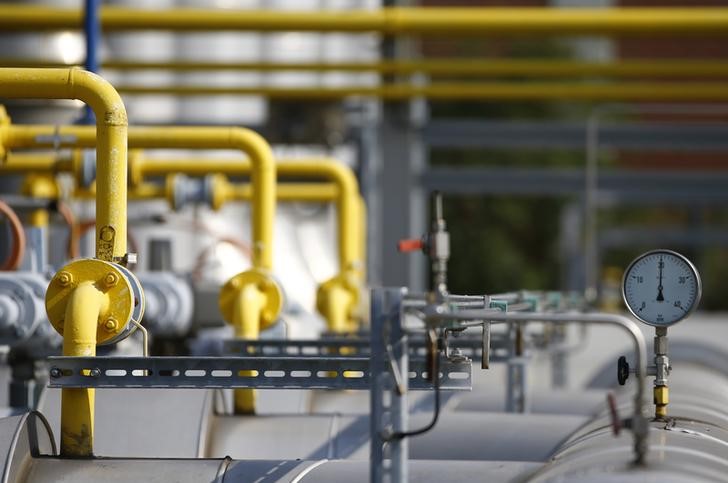(Repeats earlier story with no change to text. The opinions
expressed here are those of the author, a columnist for
Reuters.)
By Clyde Russell
LAUNCESTON, Australia, June 9 (Reuters) - Conventional
wisdom in the liquefied natural gas (LNG) sector is that no new
projects will be built for several years, given the vast cost
can't be reconciled with the current low prices.
This view has led some in the industry to predict that the
market will flip back to a structural shortage sometime in the
early to mid-2020s, once again sending prices soaring as new
supply takes so long to be built and become operational.
The cancellation or deferment of investment decisions on
several projects in Australia, Canada, the United States and
elsewhere seems to perfectly illustrate the view that no new LNG
will be coming to market once the plants currently under
construction are completed.
The wave of LNG building in recent years has seen eight
projects being built in Australia, with five now operating and
the remaining three nearing completion, and five in the United
States, the first of which has starting shipping cargoes.
This has helped drive LNG from a structural deficit to a
surplus, with the attendant decline in Asia spot prices LNG-AS
from a high of $20.50 per million British thermal units (mmBtu)
to a record low of just $4 in April this year.
Long-term contract prices linked to crude oil have also
suffered as Brent LCOc1 has slumped, further undermining the
economics of new plants.
Australia's biggest LNG operator, Woodside Petroleum
WPL.AX , shelved plans to build the $30 billion Browse LNG
project in Western Australia state in March, citing oversupply
and low prices.
Royal Dutch Shell RDSa.L and Malaysia's Petronas have also
pushed back final investment decisions on greenfield LNG
developments on Canada's west coast, and progress has slowed on
planned U.S. projects and those in frontier countries such as
Mozambique and Tanzania.
The era of mega-LNG projects appears to be over, at least
for now.
This point was underscored by Saul Kavonic, a senior analyst
at consultants Wood Mackenzie, who told the Australian Petroleum
Production and Exploration Association conference in Brisbane
this week that the country's wave of recent LNG projects had
failed to meet hurdle rates.
The average breakeven cost for the recent projects, which
will see Australia overtake Qatar as the world's biggest
supplier of the super-chilled fuel, is $12.60 per mmBtu, a price
well above the current spot level and also most long-term
oil-linked contracts.
However, while Kavonic said that building new projects is
unviable in the current situation, Australian LNG producers can
boost volumes if demand warrants increased supply.
PRODUCERS NEED TO COOPERATE
The first way to do this is through de-bottlenecking
existing plants, a process Kavonic said delivered an average 14
percent boost in capacity at LNG plants that have implemented
the efficiency measures in the past.
An additional 4 million tonnes per annum of LNG is probable
and a further 6 million possible from de-bottlenecking, Kavonic
told the conference.
These are fairly significant numbers, as 10 million tonnes
would represent an 11 percent increase in Australia's eventual
capacity and is just under half of Chinese annual demand.
The second way to boost capacity is through brownfield
expansions, which Kavonic said typically cost about 30 percent
less than building projects from scratch.
This could add more than 10 million tonnes in Australia, but
Kavonic estimates that brownfield developments would require a
price above $8 per mmBtu to be economically feasible.
A third way to boost capacity is backfill, which involves
committing new gas to existing projects to allow them to
continue operating beyond their expected and planned life.
While this doesn't add new capacity, it prevents volumes
from leaving the market, and Kavonic estimates that 15 million
tonnes of capacity could be maintained by 2030 if companies
adopt backfill policies.
What becomes clear is that there are substantial volumes of
LNG that can come to the market in the coming years at
considerably lower prices when compared to the huge cost of
developing new plants and natural gas fields to supply them.
There are of course some fairly significant hurdles, the
main one being the need for the various companies in the
industry to put aside rivalries and work together to share
infrastructure and establish joint ventures to supply natural
gas to LNG trains.
"Boys and girls don't like to share their train sets," was
how Kavonic put it, a jest that rings true when looking at the
three adjacent coal-seam gas to LNG plants recently built at
Gladstone, on Australia's east coast.
These plants don't share infrastructure even though it would
have been more cost-effective for all concerned if they had
jointly developed facilities such as pipelines, storage, jetties
and power supply.
Perhaps the expected period of low prices in the next few
years will encourage the sort of innovation and cooperation that
would allow LNG producers to increase output at competitive
costs should demand grow strongly in the 2020s.
(Editing by Christian Schmollinger)
